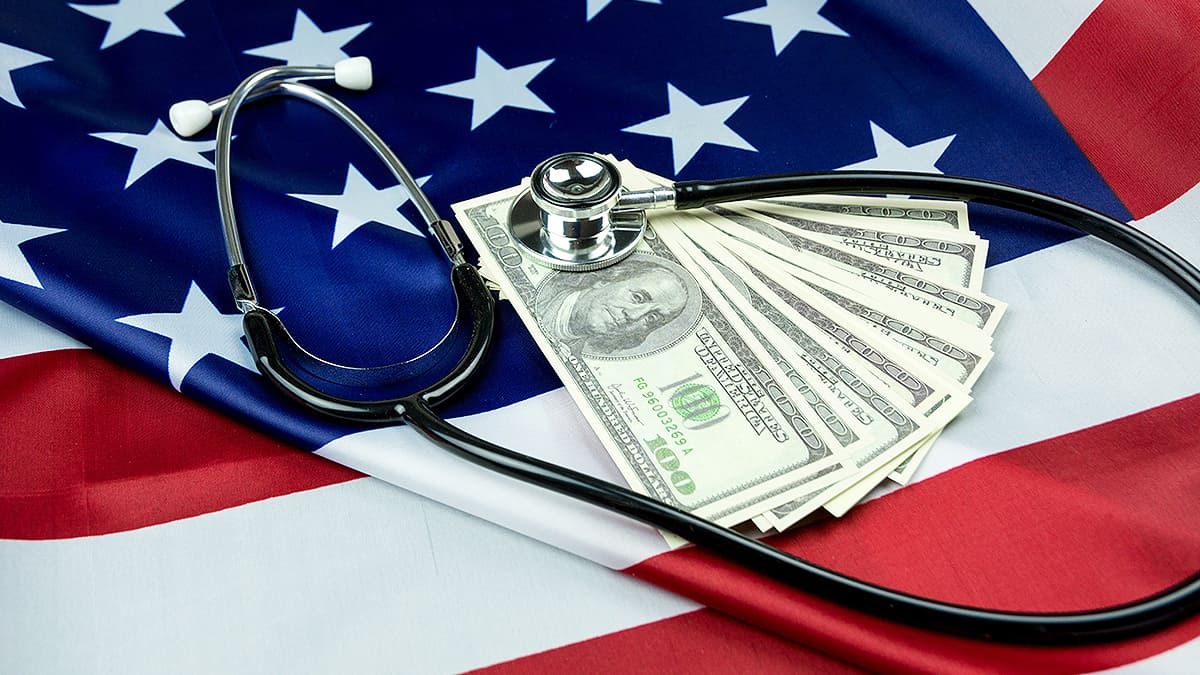Are Online Canadian Pharmacies Cheaper Even if I Have Prescription Coverage?
high drug prices

Many Americans have heard that prescription drugs from Canada are more affordable than what they typically find in American pharmacies, regardless of whether they choose to purchase them from a brick and mortar store or have them mail ordered (which is oftentimes less expensive).
What they assume is that their health insurance will take care of the price disparity. They assume that their copay will be lower than whatever the cost is to ship it in from another country. And in some cases, that's true. But it really depends on what type of coverage you have and what your copay is.
Of course, figuring all that out isn't nearly as easy as it should be. In many cases, it requires a phone call (or a few phone calls) to your insurance company to determine how much a prescription drug will cost you.
(Pro tip: you can ask them to send you a formulary so you know exactly what tier your prescriptions are in, which will help you determine how much they will cost you before you pick them up. However, this isn't foolproof, as you'll certainly find out.)
The truth of the matter is that there are many factors that determine the cost of your medication, including whether or not you are using your insurance or purchasing it outright. Here's what you need to know, and how to determine whether or not it will be cheaper through an international or Canadian pharmacy than it would be through your local pharmacy.
Major Factors that Determine Your Prescription Costs
The Type of Insurance Plan in Which You're Enrolled
One of the most significant factors in the cost of your prescriptions is the type of insurance plan in which you're enrolled. Insurance plans are as varied as they are complicated, with more expensive plans having higher premiums, but lower out of pocket costs (i.e. deductibles, copays, and prescriptions) and less expensive plans having lower premiums with higher out of pocket costs.
In theory, healthy people (who shouldn't be using their insurance as frequently) can risk a cheaper plan and it will save them money in the long run — they can pay a lower monthly premium and it should work out as long as they don't get seriously ill or are in an accident. If you're not on many prescriptions, or the ones you're on are very affordable, this can be a good option.
If you have a history of more serious health concerns (such as heart disease, asthma, blood clots, etc), you may be better off choosing an insurance plan with a higher premium because your out of pocket costs would be lower.
While this certainly applies to deductibles (the higher the premium, the lower the deductible), one of the ways that it can impact your out of pocket costs is the amount you'll pay for prescriptions. If you are on a preferred medication on a higher premium plan such as a preferred provider organization (PPO), you may pay something like $20 or $50 for a brand name medication copay.
However, if you're enrolled in a high deductible health plan (HDHP), you'll be expected to pay out of pocket for every single expense until you reach your deductible — and as the name suggests, that deductible will be high. If you see a doctor for an office visit, are injured or sick and need immediate medical attention, or need to pick up a prescription, you'll pay the entire cost of that service until you reach your deductible. After you hit that number, you'll still owe a portion of the cost, but a smaller portion. This is outlined in the terms of your insurance policy.
The cost you'll pay for your prescriptions is likely to be the negotiated rate. So you're unlikely to pay full retail price for whatever medication you need. Regardless, if you need a name brand medication, you'll be stuck paying that negotiated price, which is almost always going to be higher than it would be at a Canadian pharmacy or international pharmacy because the American government doesn't regulate this cost in the same way that many foreign governments do.

Negotiated Prices
Perhaps one of the most frustrating parts of the American insurance system is that everything is a negotiation between insurance companies and providers. One insurance company could have a different negotiated price than a different insurance company for the exact same medication. It might not be a significant difference — perhaps only a few dollars — but it's different regardless, which means it's more difficult for the consumer to keep straight.
Having so many different negotiated prices puts the onus on the consumer to find out what their expected cost will be. Therefore, each time a person switches insurance companies, they'll need to find out the new cost of their medication. And of course, if they switch insurance plans from year to year (which is more common when someone is purchasing insurance privately, as opposed to through an employer), this information can change from year to year.
To demonstrate, let's discuss asthma inhalers. There are many asthma medications that are under patent protection, which means their negotiated prices are still very high — as much as $350 for a one-month supply in the United States or even more. Needless to say, that is out of the question for many people. That's a significant portion of household income for a large portion of the population.
However, if you have an insurance company that negotiates a price lower — such as $250 for a one-month supply — that person will be able to afford their medication a bit easier (in theory) than the person who is being charged $350 per month.
Furthermore, insurance companies can negotiate which drugs are “preferred” in their formulary, which impacts their cost. Symbicort and Advair once retailed at a similar price, but some insurance companies put Symbicort on their list of preferred medications, so when people tried to fill their Advair (which was perhaps covered, but not preferred), they were paying the full price of the medication as opposed to their copay amount.
Continuing with the example of asthma inhalers, let's discuss Breo. In the United States, a one-month supply of Breo Ellipta 200-25mcg retails for about $420. Chances are, your insurance company has a lower negotiated rate that you'll pay — of course this actual price varies and the only way to find out is to call your insurance company to ask. It could be anything from $250 to $400.
The out-of-pocket cost for you will also depend on the tier in which Breo has been placed by your insurance company. Tier 1 drugs are the cheapest, Tier 2 drugs are more expensive, and Tier 3 drugs are the most expensive, and like everything else surrounding American insurance, each drug's placement is up to the insurance provider.
Now, if you have higher levels of coverage, you may have a copay of $50 or even $100 for Breo — and if that's the case, your best option may be to keep purchasing your medication from your local pharmacy. However, if you have a HDHP, or your medication isn't preferred by your insurance company, you'll end up paying the negotiated rate or the retail price. As we've already discussed, that amount is not small.
At NorthWestPharmacy.com, we have Breo Ellipta 200-25mcg for just $200. While this is still a lot of money objectively, it's potentially half of what you'd pay in the United States if it isn't a preferred medication in your insurance plan.
Individual vs. Group Coverage
Having an individual or family policy privately or through the Affordable Care Act (ACA) exchanges could mean a significant price difference in your prescription costs when compared to group coverage offered through an employer.
It's important to note that there isn't a hard and fast rule as to which type of coverage (individual or group) is cheaper. There is some debate as to whether one is cheaper, with some claiming that individual insurance is cheaper because you're not paying for other people's ailments. However, the real answer is that it just depends.
With group coverage, the premium price and by proxy, the prescription coverage, will vary according to the overall population health of the group. The sicker the group is (i.e. heart attacks, strokes, cancer, etc), the higher the prices will be, and if you don't have a large enough group over which to spread the costs, the individual amounts will be high.
With individual coverage, you're not spreading the cost across anyone but yourself. Theoretically, you're still in a group — it's just a group of all the other individuals who are purchasing private policies. However, the same rules do not apply as they would in a group coverage situation because negotiations between the employer and the insurance company do not occur, which is oftentimes how prices are lowered for the insured party.

The Fine Print
The final aspect of this matter boils down to how your prescription costs are treated in relation to your insurance plan, particularly if you're enrolled in a HDHP. Depending on how the insurance policy is laid out, the cost of your prescriptions may or may not contribute to your deductible amount (more often than not, it does not count toward your deductible and you're essentially eating this cost on your own).
The reason the fine print on your type of insurance plan is such a major factor here is that your provider may not start picking up any portion of the bill until you reach your deductible. If you're spending $400 per month on medication and it doesn't even get you closer to your $5,000 deductible, how much good is that doing you? You'll still be spending $400 each month on medication and you'll still have to pay $5,000 out of pocket — in addition to your prescriptions — before your insurance company starts picking up their share.
Furthermore, prescription purchases from an Canadian pharmacies are unlikely to count towards your deductible, regardless of the fine print because you're not using your insurance policy in order to purchase them. Canadian and international pharmacies cannot accept American insurance policies, and even if we could, we'd be out of network for Americans. However, in some cases, insurance companies will accept receipts from a Canadian pharmacy and provide coverage for them. It's best to check with your particular insurance provider.
Do Your Research
If all of this information is confusing or frustrating, know that you're not alone in that feeling. Many Americans are in similar situations and are trying to find ways around their massive, burdensome medical bills. The best thing you can do for yourself in the short-term is to arm yourself with information.
The better you understand how your insurance plan works and what out-of-pocket costs you'll be expected to pay, the more likely you'll be to find ways to save money in both the short and long-term. Simple actions like checking the price of your medications with international pharmacies can save you hundreds of dollars per month without needing to compromise your health.
At NorthWestPharmacy.com, we ship your exact medication straight to your door. There's no need for you to make a special trip, argue with your insurance company over the phone, or even sign for a package. You'll have everything you need inside one parcel, whether it's a one month or a three month supply.
If this is the first time you've considered buying your medication from an international or Canadian pharmacy, we're more than happy to walk you through the process over the phone. Our call center is open seven days a week, and our highly trained customer service representatives can answer any of your questions.
You shouldn't have to pay double or more what your Canadian neighbors are paying for your medication — the exact same medication. Even if you're not ready to place an order, you may benefit from doing some research, so don't hesitate to give us a call. We even have a toll-free number for Americans (1-866-539-5330), or you can email us at CustomerService@NorthWestPharmacy.com. We look forward to speaking with you and helping you save some money.